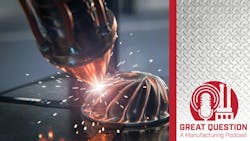Podcast: Additive manufacturing and bridging the gap between prototypes and production
In this episode, Robert Brooks, editor-in-chief at American Machinist, a sister brand to Smart Industry, delves back into additive manufacturing, analyzing the current state of the AM sector, after several years of organizational turmoil among top suppliers of additive systems.
Podcast: Has additive peaked or is the marketplace for 3D manufacturing simply shifting?
In his Great Question: A Manufacturing Podcast, Brooks argues that the turmoil in AM has had virtually nothing to do with processes or technology developments in the sector, adding that investors have been impatient with the rate of worldwide adoption of the 3D printing process.
Below is a partial transcript of this podcast:
About the Podcast
Great Question: A Manufacturing Podcast offers news and information for the people who make, store, and move things and those who manage and maintain the facilities where that work gets done. Manufacturers from chemical producers to automakers to machine shops can listen for critical insights into the technologies, economic conditions, and best practices that can influence how to best run facilities to reach operational excellence.
Robert Brooks: Recently there has emerged some concern or confusion about whether U.S. import tariffs on steel and aluminum will affect prototype products made in those materials, which is worth a separate discussion, but Patrick Wirt's article preceded that for us. His focus is on prototyping, however, which is why I bring it to your attention.
See also: Nano Dimension explores ‘strategic alternatives’ for Desktop Metal
I view the article as a helpful return to baseline for additive manufacturing after several years of organizational turmoil among the top suppliers of AM systems. That turmoil had virtually nothing to do with AM processes or technology developments, and it had almost everything to do with the finances of that industrial sector.
Now here I'm editorializing to add that the organization and finances of the additive manufacturing and 3D printing sector had been distorted because investors were impatient with the rate of adoption of those technologies among manufacturers worldwide.
Those backers wanted additive manufacturing and 3D printing to be much more disruptive to manufacturing than it has been. (There are numerous reports that American Machinist and Foundry magazine describing all those developments since 2022.) But that upheaval has stabilized since the start of this year, I'm glad to report.
See also: Nano Dimension wraps acquisition of Desktop Metal
The latest issue of the Wohlers Report, which is the most widely recognized source of additive manufacturing market intelligence, offers that in 2024 the global AM industry reached $21.9 billion in market value, up 9.1% from 2023. The new total included $4.44 billion from material sales, $6 billion from machine sales and related services, $10.1 billion from printing services, and $1.4 billion in sales from software.
Most of the growth for the industry last year was centered in Asia, especially in China. Wohlers reports that for Europe there was just moderate growth in the additive manufacturing sector, but in North America there was negative growth, so the additive manufacturing sector needs more European and North American adopters of their technologies.
This is the reason that Patrick Wirt’s article is relevant, particularly in the context of import tariffs, which many machine shops and other manufacturers may anticipate will draw more inquiries for their services. This article makes the case a current one but referencing factors that have been well established that adopting additive manufacturing and 3D printing has practical advantages that support and enhance established manufacturing operations.
I quote the author:
“Speed is one of the most significant advantages of additive manufacturing in the prototyping phase between product design and production planning. In conventional workflows, creating a single metal prototype may require days or even weeks, especially when toolpaths, workholding, and custom fixtures are involved.
“In contrast, AM allows same-day turnaround for functional prototypes, particularly when using polymer-based systems or metal binder jetting. Faster prototypes allow engineers to evaluate and revise designs early and often. This rapid iteration has several practical effects:
- Accelerated design validation: Get real-world feedback quickly without waiting on lengthy machine set-ups.
- Reduced bottlenecks: Design and development timelines can shrink significantly.
- Cost savings: Errors are caught earlier, reducing the risk of expensive late-stage redesigns.
"Machine shops using AM in tandem with CAD/CAM workflows can produce test parts overnight and run dimensional or functional checks first thing the next morning. This not only streamlines development cycles, but also:
- Increases shop flexibility for last-minute client changes.
- Improves throughput by minimizing downtime between design and machining.
- Builds client trust through faster response times and visible progress.
"Another important benefit of additive manufacturing is cost-efficiency at low volumes. Standard manufacturing often relies on economies of scale—producing a few parts can be disproportionately expensive due to set-up and tooling costs. Additive manufacturing sidesteps those costs by removing the need for custom tooling.
"Now, machine shops can offer small-batch or custom parts at competitive prices, filling a previously underserved niche. This capability is especially useful in industries such as aerospace, automotive, and medical devices, where low-volume parts may still require complex geometries and strict tolerances.”
About the Author
Scott Achelpohl
Head of Content
I've come to Smart Industry after stints in business-to-business journalism covering U.S. trucking and transportation for FleetOwner, a sister website and magazine of SI’s at Endeavor Business Media, and branches of the U.S. military for Navy League of the United States. I'm a graduate of the University of Kansas and the William Allen White School of Journalism with many years of media experience inside and outside B2B journalism. I'm a wordsmith by nature, and I edit Smart Industry and report and write all kinds of news and interactive media on the digital transformation of manufacturing.

